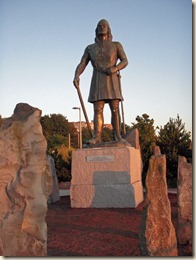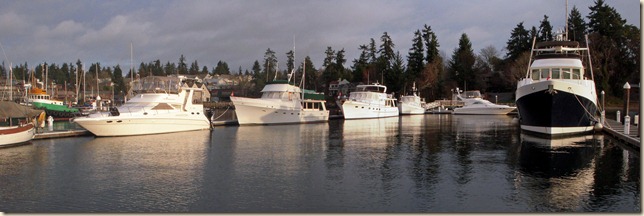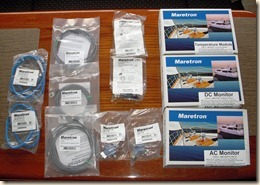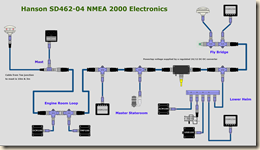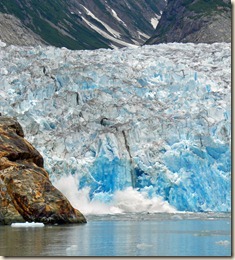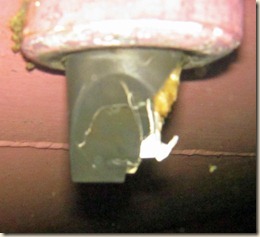One of my pet peeves about cruising blogs is infrequent updates. In the future I will have to be less peevish and more tolerant when reading someone’s blog that hasn’t been updated in six months.
My last entry (also a roll-up) recounted our life through August. Since then, we’ve made progress on the grand plan we’ve laid out for ourselves. We even managed to get a few short cruises in Puget Sound during the glorious September we had in 2012.
Our sublet of the slip at Shilshole Marina was through the end of August. The folks from whom we were subletting, Dorothy & Larry Dubia (Big Brivet) were gracious enough to let us extend our stay through Labor Day.
We left bright and early on Labor Day (September 3), had favorable currents and made it to Echo Bay on Sucia Island. It was an 11 hour grind but it gave us an extra full day without having to move the boat.
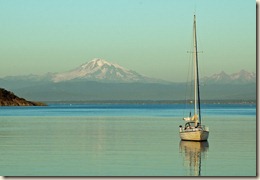 Despite a little drama (a furnace boo-boo), a little sweat (10 minutes of fussing to start the outboard on the dinghy), we thoroughly enjoyed our full day on Sucia. The view of Mt Baker from Echo Bay is always a highlight. It being the Tuesday after Labor Day, it was pretty busy and we shared Echo Bay with 25 sailboats and 20 power boats.
Despite a little drama (a furnace boo-boo), a little sweat (10 minutes of fussing to start the outboard on the dinghy), we thoroughly enjoyed our full day on Sucia. The view of Mt Baker from Echo Bay is always a highlight. It being the Tuesday after Labor Day, it was pretty busy and we shared Echo Bay with 25 sailboats and 20 power boats.
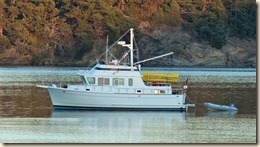 One of the boats we shared the anchorage with was our first boat, Dragontail, a Selene 36. We recognized it by the custom kayak rack on the aft cabin. It has changed hands one more time since we sold it in January 2010.
One of the boats we shared the anchorage with was our first boat, Dragontail, a Selene 36. We recognized it by the custom kayak rack on the aft cabin. It has changed hands one more time since we sold it in January 2010.
On Wednesday, September 5, we headed for another favorite spot, Prevost Harbor on Stuart Island. We did a short stop in Friday Harbor to check e-mail, make a cell phone call and buy a few provisions. We’ve not been in Friday Harbor when it was this busy before. It is fun to watch all the boats coming and going but nerve wracking if you are one of those coming or going.
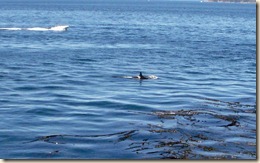 The next day, September 6, we walked to the light house at Turn Point on the west tip of the island. In the hour or so we were there, we saw four separate pods of Orca totaling at least 20 individual whales pass by from south to north. Before you’d see the orca, you’d see an entourage of power boats trailing behind pod. The photo at left was taken from shore with a small point and shoot camera with only 3x magnification. The features in the lower right of the photo are the bull kelp growing near shore.
The next day, September 6, we walked to the light house at Turn Point on the west tip of the island. In the hour or so we were there, we saw four separate pods of Orca totaling at least 20 individual whales pass by from south to north. Before you’d see the orca, you’d see an entourage of power boats trailing behind pod. The photo at left was taken from shore with a small point and shoot camera with only 3x magnification. The features in the lower right of the photo are the bull kelp growing near shore.
September 7 was a travel day in which we hoped to snag a mooring ball in Eagle Harbor on Northeast side of Cypress Island. They were all taken but we anchored in a small cove a half-mile north. In the calm conditions we had, it was delightful and surprisingly calm.
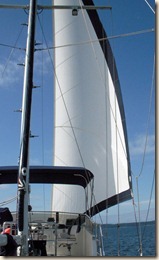 On September 8, we anchored on the north side of Hope Island, an island operated as a marine park by Washington State. Compared to Sucia Island, Hope is pretty primitive. I did a hike around the east end of the island and it was a major bushwhack in places.
On September 8, we anchored on the north side of Hope Island, an island operated as a marine park by Washington State. Compared to Sucia Island, Hope is pretty primitive. I did a hike around the east end of the island and it was a major bushwhack in places.
We arranged to meet George Buehler, the designer of our boat, on the morning of September 9 in Coupeville to get a tutorial on deploying our sails. Other than at the dock in China, we’ve never put them out. Of course, the weather decided to get sloppy for our effort and the winds picked up to 15-20 knots.
We only deployed the foresail as the rigging for the main sail needs to be worked out since we our dinghy on the boat deck gets in the way of what Seahorse Marine originally intended. While we never turned off the engine, we did go into neutral and managed 3.5 knots under sail. There was current but we have no idea whether it was helping or hindering us. Deploying the sails was a major effort and given that it normally only Marcia and I operating the boat, the sails will probably stay furled most of the time.
After we dropped off George and his wife Gail back on the dock at Coupeville, we elected to spend the night there. The weather forecast was for some weather to come in that night and anchorages in Saratoga passage are poor. It was probably not the best decision as the weather brought 30 knot gusts down the Strait of Juan deFuca over the narrow section of Whidbey Island into Penn Cove and right into the Coupeville dock. It was very bouncy for much of the night. Fortunately, the winds let down enough the next morning and we were able to get off the dock without any problem. We arrived in the early afternoon on September 10, at the Queen City Yacht Club Winslow outstation.
While there we did laundry, provisioned then headed out on September 13 for the southern section of Puget Sound. The first night was just west of the mouth of the Nisqually River.
We had hoped to take advantage of reciprocal privileges at the Olympia Yacht Club and stay at the dock in Olympia on September 14. After poking our nose all the way down to the end of Budd Inlet, we saw that no space was available and headed back out. We ended up at an anchorage off of another Washington State Marine Park named Hope Island. This Hope Island was far less ragged and offered lots of well maintained trails for walking. The anchorage was subject to considerable current, however, and it was impressive to see our boat go from one side of its anchor circle to the other as the current switched with the tides.
We trekked north on September 15 and headed for Port Madison on the north end of Bainbridge Island. We rafted with our friends the Dubia’s on their vessel Big Brivet. We first met the Dubia’s in 2007 when we transited Yuculta, Gillard and Dent narrows the same day.
The next day, September 16, we headed back to Winslow the long way, via Agate Pass and Rich Passage. After a few days in which to do laundry and reprovision, we headed back north to the San Juans.
We anchored just outside the Port Townsend Marina for the night. Since the winds were out of the northwest, it was pretty protected. From there, we crossed the Strait of Juan deFuca in fine conditions and again headed to Prevost Harbor on Stuart Island. While we saw some Orca on the west side of San Juan Island, we didn’t have the display off Turn Point that we did two weeks earlier.
 After two nights, we headed south. As we passed the south side of Jones Island, we spied our sistership, ZanaZu, owned by Nancy & Asrar Zubair. Since it was still early in the morning, we didn’t roust them up by sounding our horn off their stern.
After two nights, we headed south. As we passed the south side of Jones Island, we spied our sistership, ZanaZu, owned by Nancy & Asrar Zubair. Since it was still early in the morning, we didn’t roust them up by sounding our horn off their stern.
We continued across the Strait and anchored again off Port Townsend. By early afternoon the next day, we were secured at the Winslow outstation for the winter.

